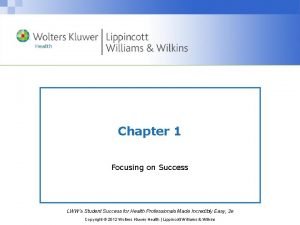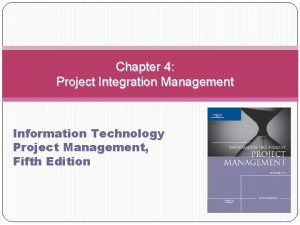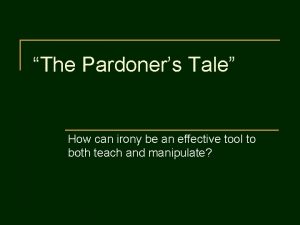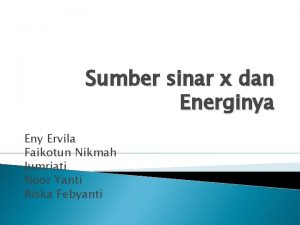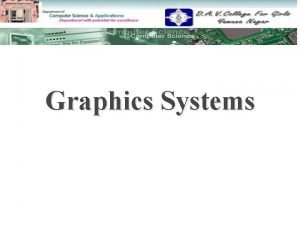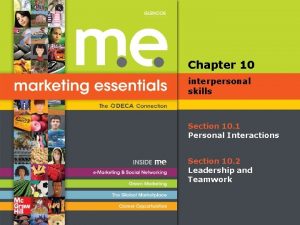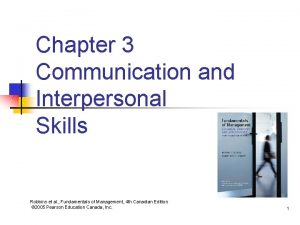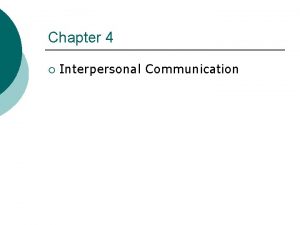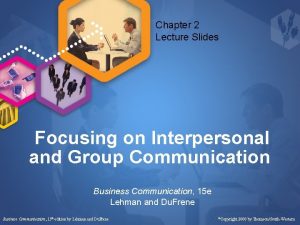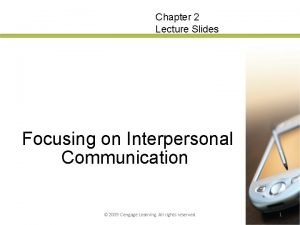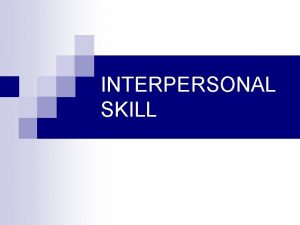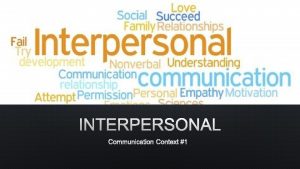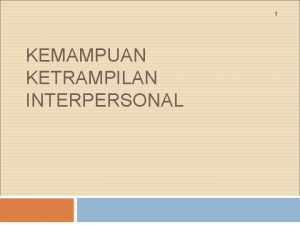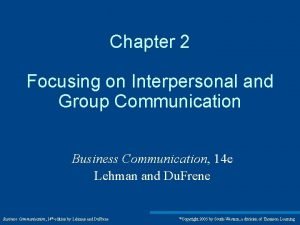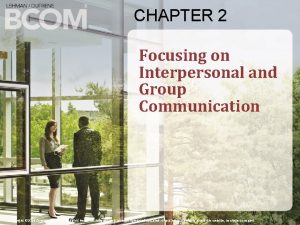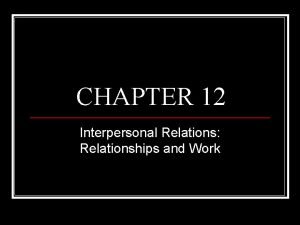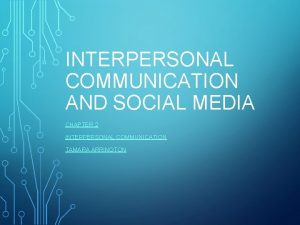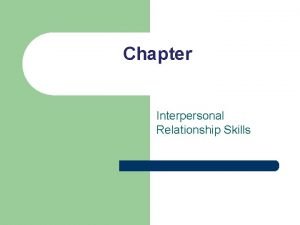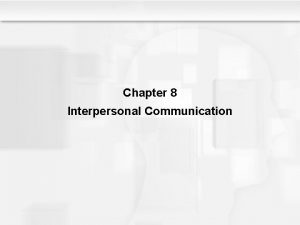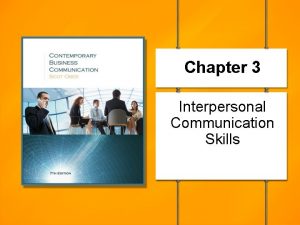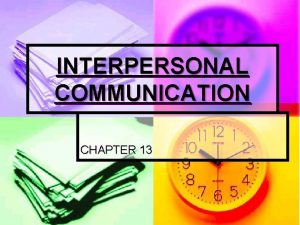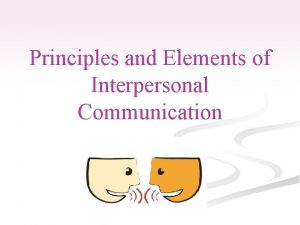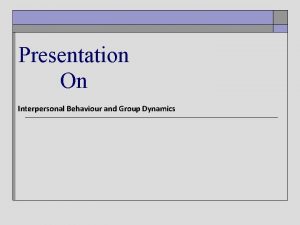Chapter 2 Lecture Slides Focusing on Interpersonal and


























- Slides: 26

Chapter 2 Lecture Slides Focusing on Interpersonal and Group Communication Business Communication, 15 e Lehman and Du. Frene Business Communication, 15 th edition by Lehman and Du. Frene Copyright 2008 by Thomson/South-Western

Chapter 2 Topics 1. Behavioral Theories and their impact on Business Communications 2. Nonverbal Communication 3. Effective Listening 4. Group/Team Communication 5. Meeting Management Chapter 2 Business Communication, 15 th edition by Lehman and Du. Frene Copyright 2008 by Thomson/South-Western

Behavioral Theories That Impact Communication • Maslow’s Hierarchy of Needs • Mc. Gregor’s Theory X and Y • Hersey and Blanchard’s Situational Leadership Model • Mc. Clelland’s Acquired Needs Theory Chapter 2 Business Communication, 15 th edition by Lehman and Du. Frene Copyright 2008 by Thomson/South-Western

Maslow’s Hierarchy of Needs – humans will strive to meet needs, only moving on to higher level needs once a need is met. Implication – In order to motivate people, you must try to meet the lowest level of unmet needs that they have .

Maslow’s Hierarchy of Needs Higher-order needs Selfactualization Self-fulfillment Esteem or ego Recognition, Confidence, Success, Strength Social Acceptance, Belonging, Love, Affection Safety Security, Protection, Comfort, Peace, Surroundings Physiological Food, Thirst, Sleep, Health, Body needs, Exercise, Rest Mc. Graw-Hill/Irwin Lower-order needs © 2005 The Mc. Graw-Hill Companies, Inc. All rights reserved.

Maslow’s Hierarchy of Needs Highest-level needs Lowest-level needs Needs Description Examples Selfactualization Realize one’s full potential Use abilities to the fullest Esteem Feel good about oneself Promotions and recognition Belongingness Social interaction, love Interpersonal relations, parties Safety Security, stability Job security, health insurance Physiological Food, water, shelter Basic pay level to buy items Lower-level needs must be satisfied before higher-level needs are addressed. 13 -6

Mc. Gregor’s Management Styles Theory X Theory Y • Workers inherently _______ dislike work challenging • Workers like ______ work • Talent is narrowly _____ distributed among only a few widely • Talent is _______ distributed throughout the workforce • Workers will do as little _______ work as ______ they are required to do • Workers can be motivated independently to work _______ Chapter 2 Business Communication, 15 th edition by Lehman and Du. Frene Copyright 2008 by Thomson/South-Western

Hersey and Blanchard’s Situational Leadership Model Leadership style must be appropriate for the follower and the task being performed. Directive behavior vs. Supportive behavior Chapter 2 Business Communication, 15 th edition by Lehman and Du. Frene Copyright 2008 by Thomson/South-Western

Motivation Theory #3 – Mc. Clelland’s Acquired Needs Theory People acquire 3 groups of needs through their life experiences, especially early in life: • Need for Achievement – motivated by meeting challenges and excelling at work • Need for Power – motivated by responsibility and influence over others • Need for Affiliation – motivated by approval and building relationships . Implication - If a manager understands which of these 3 types of needs is most important for an employee, then they can be motivated accordingly

Motivation Theory #3 – Mc. Clelland’s Acquired Needs Theory Q. Based upon the Mc. Clelland’s Theory, what Need are you most motivated by? • Need for Achievement – motivated by meeting challenges • Need for Power – motivated by responsibility • Need for Affiliation – motivated by approval

Motivation Theory #3 – Mc. Clelland’s Acquired Needs Theory * Implication - You will likely be happiest by seeking out a work environment that matches your primary Need: • N power - Likely to be happiest in jobs that give you control over budgets, people, and decision-making. • N achievement - Likely to be happiest working in an environment in which you can create something new. • N affiliation – Likely to happiest when you can be working with other people and can form friendships. Mc. Graw-Hill/Irwin © 2005 The Mc. Graw-Hill Companies, Inc. All rights reserved.

Nonverbal Communication – without the use of words • Metacommunication – a message expressed, though not overtly stated (ex: “Don’t be late tomorrow” • Kinesics – nonverbal behavior which conveys meaning (examples page 50) • – Visual – gestures, eye movements, smiles – Vocal – intonation, volume, pitch Proxemics – distance during communication Chapter 2 Business Communication, 15 th edition by Lehman and Du. Frene Copyright 2008 by Thomson/South-Western

Understanding Nonverbal Communication • Every Communication contains nonverbals • Interpretations may vary wildly by person • Interpretations may vary wildly by culture • Can be intentional or subconscious • Verbals and nonverbals can conflict • Nonverbals may “drown out” verbal messages • Nonverbals may increase or decrease the effectiveness of verbal messages Chapter 2 Business Communication, 15 th edition by Lehman and Du. Frene Copyright 2008 by Thomson/South-Western

Are you a good listener? • Are you open to what other people say to you, or do you make up your mind about things before you hear other views? • Do you become bored when other people speak? • Do you interrupt people when they are speaking? • Do you daydream while others are speaking? • Are you hesitant to ask clarifying questions? Mc. Graw-Hill/Irwin © 2005 The Mc. Graw-Hill Companies, Inc. All rights reserved.

Types of Listening 1. Casual listening – for pleasure 2. Listening for information – to extract the main points being communicated 3. Intensive listening – analyze while listening to soak up information and interact with others 4. Empathetic listening – try to understand not just what is said, but why it is being said and how the speaker feels Chapter 2 Business Communication, 15 th edition by Lehman and Du. Frene Copyright 2008 by Thomson/South-Western

Bad Listening Habits • Faking attention • Allowing or hoping for disruptions • Overlistening – trying to take in every detail and missing main points • Stereotyping – age, gender, appearance, accents, mannerisms • Dismissing subjects as uninteresting (no value) • Failing to observe nonverbals Chapter 2 Business Communication, 15 th edition by Lehman and Du. Frene Copyright 2008 by Thomson/South-Western

Ten Commandments for Good Listening 1. Stop talking! You cannot listen if you are talking. 2. Put the talker at ease. Help the talker feel free to talk. 3. Show the talker that you Look and act interested. Do not read your mail while he or she talks. want to listen. 4. Remove distractions. Do not doodle or shuffle papers. Shut the door? 5. Empathize with the talker. Try to put yourself in the talker’s place so that you can see his or her point of view. .

Ten Commandments for Good Listening 6. Be patient. Allow plenty of time. Do not interrupt the talker. 7. Hold your temper. An angry person gets the wrong meaning from words. 8. Go easy on argument and criticism. This puts the talker on the defensive. He or she may “clam up” or get angry. Do not argue: even if you win, you lose. . 9. Ask questions. This encourages the talker and shows you are listening. It helps to develop points further. 10. Stop talking! This is the first and last commandment, because all other commandments

Characteristics of Effective Groups Covered in Chapter 1!! Chapter 2 Business Communication, 15 th edition by Lehman and Du. Frene Copyright 2008 by Thomson/South-Western

Group Roles (pages 59 -60) Positive Negative • • Isolator Dominator Free rider Detractor Digressor Airhead Socializer • • • Chapter 2 Business Communication, 15 th edition by Lehman and Du. Frene Facilitator Harmonizer Record keeper Reporter Leader Copyright 2008 by Thomson/South-Western

The Stages of Group Development Figure 15. 4 15 -21

Stages of Team Development 1. Forming – Establishing expectations, identifying skills & personalities, and defining authority 2. Storming – Conflict emerges due to role establishment and challenging each other 3. Norming – agreeing on roles, rules, and behavior 4. Performing – Focusing on solving problems and meeting challenges. Until working through steps 13, a team can’t get in a position to succeed 5. Adjourning – Job is finished & team disbands

“Performing” Team Behaviors • Commitment — focus on mission, values, goals, and expectations • Cooperation — share a sense of purpose • Communication — know that information must flow smoothly • Contribution — expect all members to share abilities and skills with the team Chapter 2 Business Communication, 15 th edition by Lehman and Du. Frene Copyright 2008 by Thomson/South-Western

Face-to-Face Meetings Disadvantages Advantages • Provide rich, nonverbal cues • Are preferred when dealing with sensitive issues • • Pose logistical issues of time, place, and schedules • May be dominated by aggressive and high-status members Are beneficial for rapport Chapter 2 Business Communication, 15 th edition by Lehman and Du. Frene Copyright 2008 by Thomson/South-Western

Electronic Meetings Disadvantages Advantages • Assist with geographically scattered groups • Speed up meeting follow-up activities • Place all participants on a more even level • Cannot replace face-to-face contact for some meetings • Can make consensus harder to reach • Are dependent upon keyboarding skills Chapter 2 Business Communication, 15 th edition by Lehman and Du. Frene Copyright 2008 by Thomson/South-Western

Suggestions for Effective Meetings 1. Question whether it is really necessary 2. Limit length and frequency 3. Plan arrangements satisfactorily 4. Distribute an agenda 5. Encourage participation (as appropriate) 6. Maintain order and professionalism 7. Manage Conflict ( + and -) 8. Seek consensus / Make decisions Chapter 2 Business Communication, 15 th edition by Lehman and Du. Frene Copyright 2008 by Thomson/South-Western
 Chapter 1 focusing on success powerpoint
Chapter 1 focusing on success powerpoint A small child slides down the four frictionless slides
A small child slides down the four frictionless slides Starting from rest a marble first rolls down
Starting from rest a marble first rolls down Principles of economics powerpoint lecture slides
Principles of economics powerpoint lecture slides Machine learning course slides
Machine learning course slides Business communication lecture slides
Business communication lecture slides 01:640:244 lecture notes - lecture 15: plat, idah, farad
01:640:244 lecture notes - lecture 15: plat, idah, farad Five focusing steps
Five focusing steps Example of project integration management
Example of project integration management Isoelectric focusing
Isoelectric focusing Sarah bohndiek
Sarah bohndiek Project integration management example
Project integration management example Awareness requires totally focusing attention on the task
Awareness requires totally focusing attention on the task Irony in the pardoners tale
Irony in the pardoners tale When focusing a specimen you should always start with the
When focusing a specimen you should always start with the Different types of microscope and their uses
Different types of microscope and their uses Fungsi dari metalic focusing cup adalah
Fungsi dari metalic focusing cup adalah Site:slidetodoc.com
Site:slidetodoc.com When focusing a specimen, you should always start with the
When focusing a specimen, you should always start with the Part of the microscope
Part of the microscope Display devices in computer graphics
Display devices in computer graphics Types of microscopes
Types of microscopes 6 interpersonal skills
6 interpersonal skills 10 interpersonal skills
10 interpersonal skills Chapter 5 interpersonal communication
Chapter 5 interpersonal communication Interpersonal communication chapter 3
Interpersonal communication chapter 3 Communication process noise
Communication process noise
